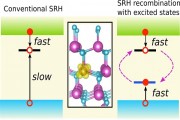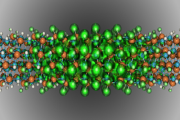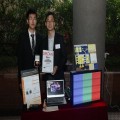 2016-11-04
2016-11-04
Using cutting-edge first-principles calculations, researchers at the University of California, Santa Barbara (UCSB) have demonstrated the mechanism by which transition metal impurities - iron in particular - can act as nonradiative recombination centers in nitride semiconductors. The work highlights that such impurities can have a detrimental impact on the efficiency of light-emitting diodes (LEDs) based on gallium nitride or indium gallium nitride.
Continue reading →
2014-04-14
NTNU researchers Dheeraj Dasa and Helge Weman have, in cooperation with IBM, discovered that gallium arsenide can be tuned with a small strain to function efficiently as a single light-emitting diode or a photodetector. This is facilitated by the special hexagonal crystal structure, referred to as wurtzite, which the NTNU researchers have succeeded in growing in the MBE lab at NTNU. The results were published in Nature Communications this week.
Continue reading →
 2014-04-07
2014-04-07
Nanostructures half the breadth of a DNA strand could improve the efficiency of light emitting diodes (LEDs), especially in the “green gap,” a portion of the spectrum where LED efficiency plunges, simulations at the U.S. Department of Energy’s National Energy Research Scientific Computing Center (NERSC) have shown.
Continue reading →
2014-02-26
Dow Corning, a global leader in silicones, silicon-based technology and innovation, announced today that Kaz Maruyama, global industry director for Dow Corning Lighting Solutions, will deliver a presentation at the 15th Edition of Strategies in Light in Santa Clara, Calif. Titled “Materials Solutions for Maximizing LED Package Efficiency,” the presentation will detail how new high-performance optical silicones are increasing the efficiency of LED packaging design.
Continue reading →
 2013-09-09
2013-09-09
Hong Kong Polytechnic University’s (PolyU) Department of Electronic and Information Engineering has recently developed a high efficiency Pulse-Width Modulation (PWM) LED driver that will allow LED lamps to become brighter and more efficient.
Continue reading →
2010-07-21
Osram Opto Semiconductor's prototype of a red Golden Dragon Plus LED sets new record
Developers at OSRAM Opto Semiconductors have succeeded in increasing the efficiency of red thin-film LEDs by 30% – a new record. The latest generation of thin-film chips benefit from an optimized chip platform which has potential for further improvements. This boost in efficiency is opening up new LED applications in general illumination, in projection and in the industrial sector.
Continue reading →
2008-11-14
According to an industry executive at the Electronica 2008 exhibition, the integration of intelligence with LED technology will lead to a greater significant energy savings for many lighting applications.
Continue reading →
 2016-11-04
2016-11-04
 2014-04-07
2014-04-07
 2013-09-09
2013-09-09